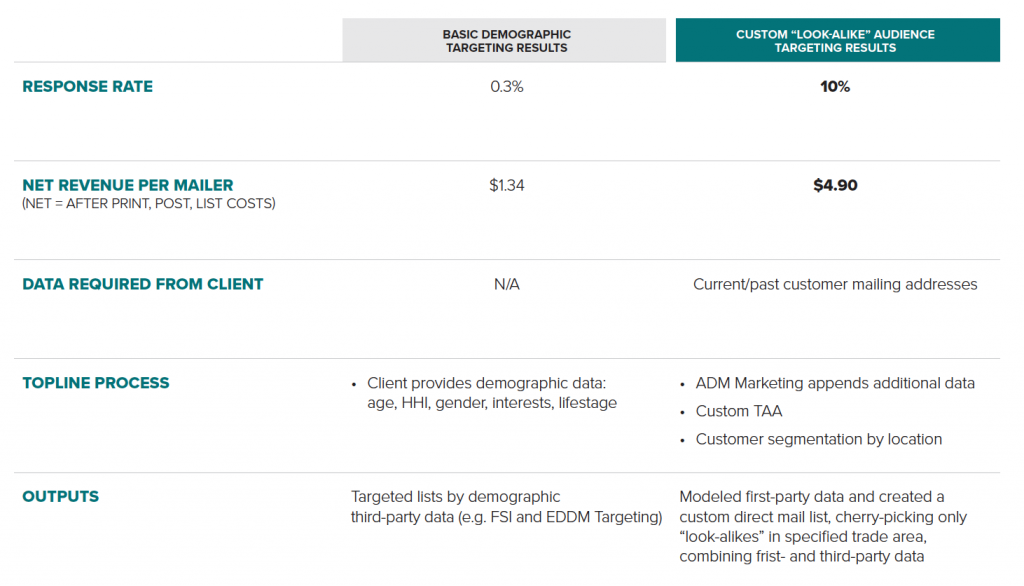The core of all successful businesses is new customer growth. But targeting potential new customers at an efficient Cost Per Acquisition, especially during challenging times, can be daunting. To expand your base audience, look no further than your own customer data. Imagine overlaying over 1,000 points of data to each of your customers to deeply understand who they are in order to identify others that “look” like them. This technique is called a “look-alike audience”, or “clone marketing.” It is so highly targeted that it lowers new customer acquisition costs and results in an impressive ROI while expanding the brand’s audience. This article is an overview of our refined process for cloning customers to help you better understand how we do this and the outcome for our clients.
What is Look-alike Modeling?
First, let’s review what look-alike modeling is not! Do you recall a memory matching game that children play for developing their cognitive skills? An array of brightly colored cards lie face down on a table: one side is blank and the other side is printed with pictures and words. The player flips over the cards two at a time, if they match then the two cards are removed. Some marketers use a similar technique to identify and match their current customers using only a handful of data points such as age, gender, individual and/or household income, and other very basic demographic data. But with innovations in data marketing, this method is no longer worth the effort or the money.
In this data-driven marketing era, consumer data-modeling better predicts your target audience and gives brands the edge on their competition. We “clone” our client’s customers to find “look-alikes” by overlaying 1,000 points of data, including basic demographics and interests. This deep dive allows us to identify individual prospects and send marketing messages directly to them. We can go even a step further by overlaying all of your client’s customer purchase behavior. With this data, we build models for highest value to lowest value customers and prospects, fine-tuning the targeting even further. If a retailer has multiple units, we are able to model these audiences by individual location. For e-commerce companies, results are location agnostic, but we have the ability to target specific areas, ZIP codes, and even carrier routes, and cherry-pick individual consumers within a specified ZIP versus waste mailing to the entire ZIP code.
How Does Look-alike Modeling Convert Consumers?
A highly developed and customized “look-alike” model allows all forms of media to reach your prospects in a hyper-targeted way and because these marketing efforts are tied to an individual address, we can trace an individual’s response to the initiative.
But, does it actually work? “To be honest, we’ve never seen it not work,” says Stephen Farr-Jones, founder and President of ADM Marketing. Most clients begin by testing our customer model through a targeted direct mail program. After every marketing effort, we analyze the results and, from there, expand the efforts using the same model to meet our client’s business goals. Typically, the “look-alike” model becomes our clients’ point of reference for all their marketing efforts. We update the model periodically with new consumer data as the business evolves.
To help visualize, check out this case study of a multi-unit retail chain that was able to increase ROI after working with our custom-built look-alike model. This new model resulted in over a 25% increase in net revenue per mailer. See below for a before-and-after summary of a new prospect marketing model for this client.

How Do I Get Started?
With 17 years of experience, this modeling system is built on our knowledge of the value of data-driven marketing strategies and is rooted in a passion for driving a positive ROI for our clients. But don’t take our word for it: 90% of our clients were referred to us by existing clients.
Data intelligence drives better business and marketing decisions. We have the unique ability to mine for the data points needed, rework the data into the most meaningful, useful insights, track what happened and, ultimately, deliver better performance through highly targeted marketing programs. For more on how we identify the data within your company that will be the most valuable in driving ROI and how we utilize data, check out some of our case studies.